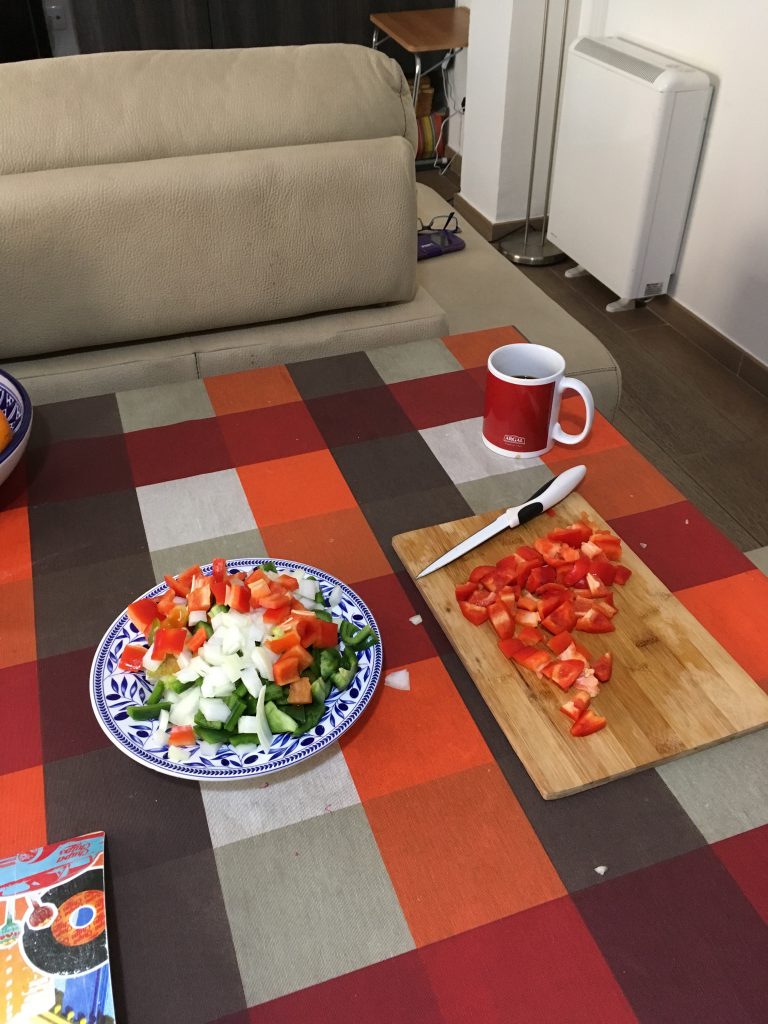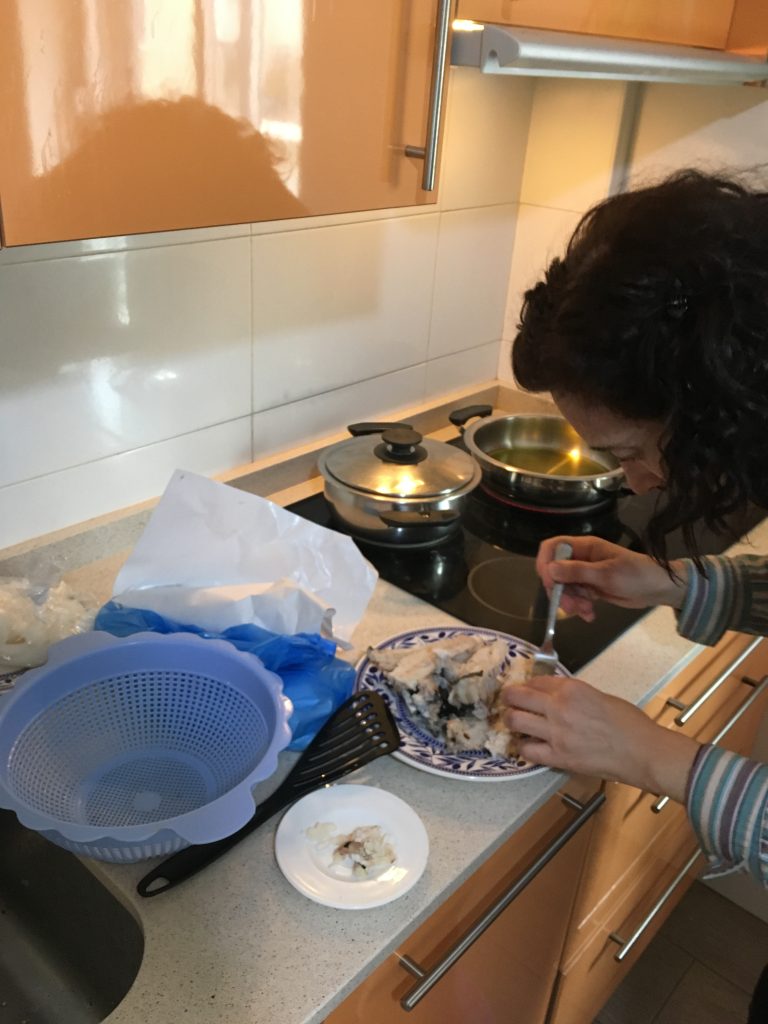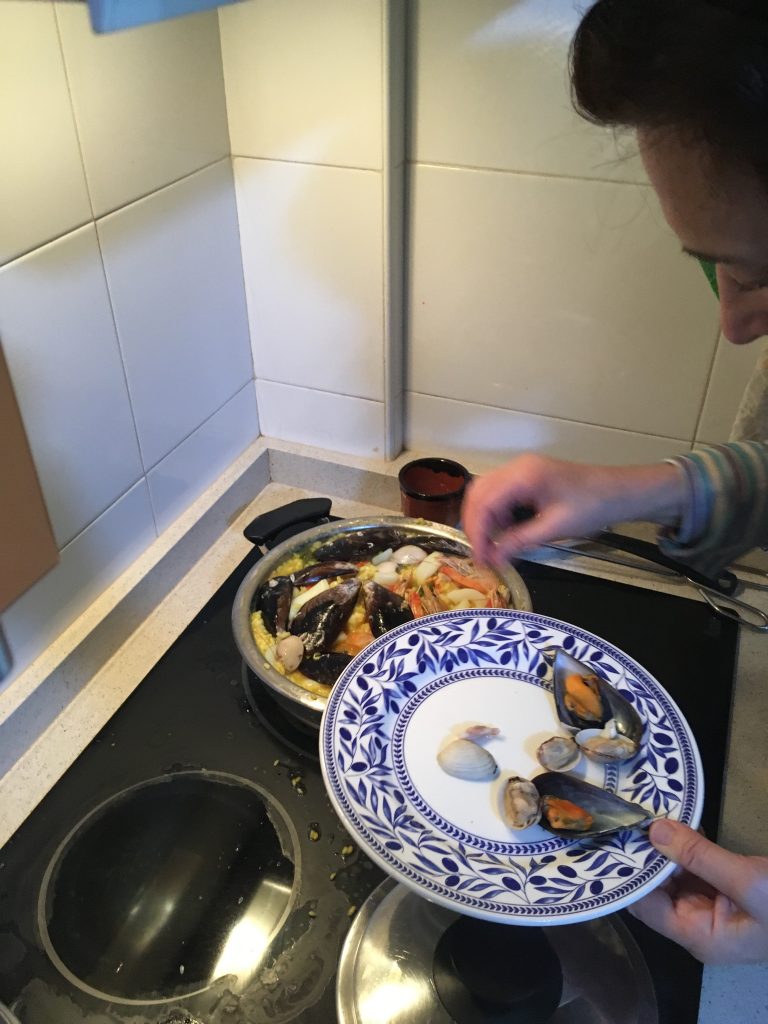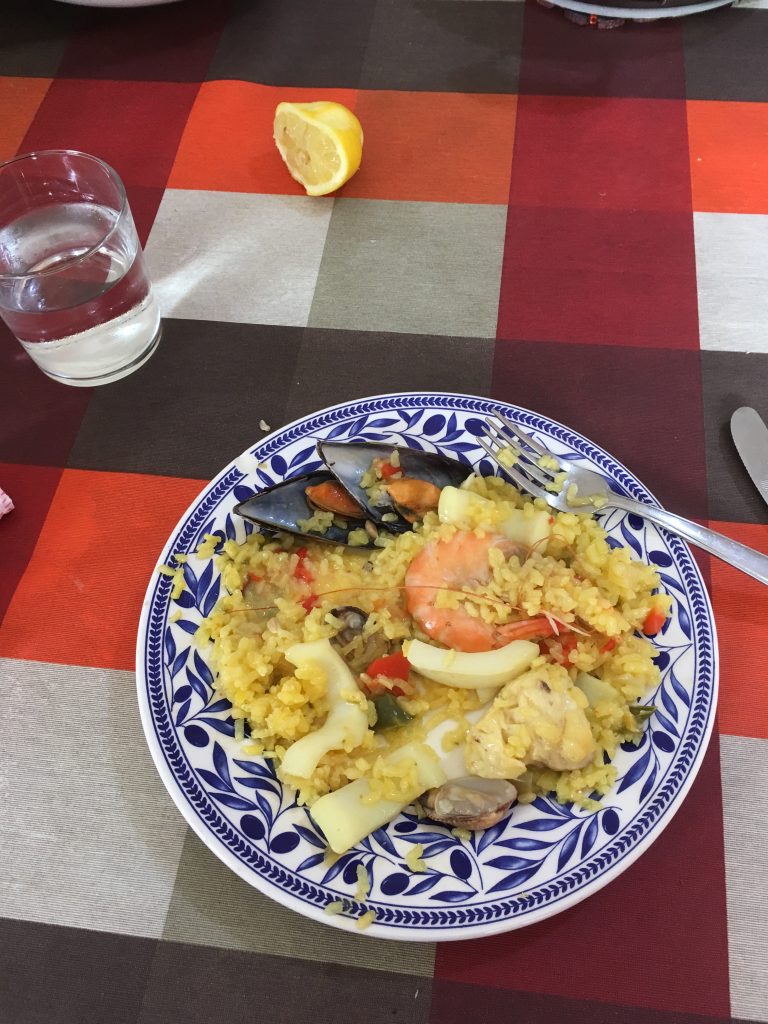Sundays in Spain, as they are traditionally known, are for making paella. For those of you unfamiliar with this Spanish dish, it is perhaps the most well-known and best tasting cuisine you could really ask for in Spain. It consists of a delicious mixture of seafood, rice, vegetables and sometimes (although not this time) rabbit. For those of you who have had paella, you certainly understand why it deserves a blog post of its own. This week my host mom asked me if I wanted to learn how to make this sea-food and rice wonder. I delightfully accepted. So, today, I intend to blog a step-by-step process of what I learned (for my memory’s sake as well as for you all). Although you can always find “recipes” online, my host-mom insists hers is the most authentic.
DISCLAIMER: All measurements are 100% eyeballed because according to my mom, “real cooking doesn’t have a recipe”. Let’s begin.
1.) We cut: onions, red peppers, and green peppers. Done.

2.) Heat up some olive oil in a saucepan (pictured below, the pan on t he far right). Once the oil is hot, throw in all your veggies.
he far right). Once the oil is hot, throw in all your veggies.
3.) The most important part of paella is the broth. This is where all the flavor comes from (there are no spices involved in paella). To make the broth you take basically all the stuff that the fish market throws away (fish bones, fish heads, skin, etc), and put it in water and boil it for 15-20 minutes (that’s what’s in the covered pot on the right). You’re welcome for forgetting to take a picture of this step.
4.) You take out the fish eye balls, bones, and guts, and, leaving the “broth”, throw them away. In the trash. My mom is depicted (above) picking the meat off the “trash items”. This step is optional. She really likes fish, I guess. Now we can get to the real cooking.
5.) Clean (slightly) some fresh mussels and put them into the broth. Boil them in the broth for 5 minutes or until they open up. Take them out, leave the broth. Set aside. Take off the side of the shell without any meat on it. Trash.
6.) Clean some fresh clams. Repeat step 5.
7.) By this time your veggies are probably ready. Take all that tasty fish/mussel/clam-broth you just made and pour it right into your veggie pan with a colander! The colander of course, to sift out the stray fish-eye here and there.
8.) Dump some rice into the mixture (about 1 cup per person) and boil it. You can’t really use basmati rice, or even long grain rice for that matter (the rice has to have no flavor to best absorb the fish flavor). Use round short-grain rice.
9.) Salt indiscriminately. I think my mom had her eyes shut for this part. Not sure. Like I said before, this is the ONLY SPICE/HERB/ANYTHING in this entire dish, and she barely put any in. Less is more, blah, blah, blah.
10.) Clean some fresh fish filet, and throw them right on top. I think you also have to say, “Ole!”, when you do it for it to be effective. (Remember, clean as little as possible in order to leave the flavor of the fish). Choose a fish you like. My mom chose her favorite (and Spain’s most popular paella fish), Monkfish. This fish is perhaps the ugliest living thing I’ve ever seen, but tasted magical.
11.) Cut up some fresh calamari, and throw it on top of this magical boiling Spanish stew. Keep a light boil going throughout this whole thing.
12.) Time for some gambas. Er, I mean, shrimp! Whole shrimp. Head, eyes, and all. My mom used krill instead, but shrimp is most common. Remember, fresh!
13.) Remember those mussels and clams? They’re already cooked, so go ahead and toss them on top of everything too. (Pictured below, you will start to notice you’re running out of room in the pot, and it becomes like playing Tetris, fitting in al l the seafood!)
l the seafood!)
14.) Let the mussels and clams heat back up (face down, of course), let the rice finish its last few minutes, and remove from heat.
15.) Put the pot on the table next to a couple of lemons cut in half. Feel free to douse your rice with some lemon juice. This, so they say, is they authentic way to eat paella.
16.) (Below) Serve in giant heaps on your plate and dig in! Make sure you have a communal “trash plate”, where you can throw your shrimp tails, mussel shells, etc.
17.) A glass of white wine is MOST typical, but my host brother is 17 (sorry, man), and also my host mom forgot to pick some up, so water works fine too!

Note*** “Old style” paella typically contained saffron, a herb/spice that gave the traditional dish a yellow color. Saffron got too expensive to say the least. Buying enough saffron to make our dish today would have costed us about $50 USD. Since the flavor of saffron “really doesn’t matter or change the dish that much”, we didn’t use it today. I commented on the lack of color (I’ve seen pictures in textbooks, okay?) so my mom added some yellow food coloring at the very end just for me, so I could feel like my paella experience was more “authentic”. The things we do for our guests, I guess.
Enjoy!

